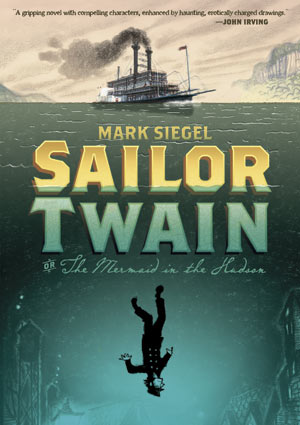The past year produced some incredible graphic novels, especially in the science fiction arena. One of 2012’s strongest premieres is Saga, Vol. 1 (Image Comics, $9.99). Against a backdrop of interstellar war, creators Brian K. Vaughan and Fiona Staples cast an intimate story of one young family’s struggle to survive. Alana and Marko, a pair of (quite literally) star-crossed lovers, take a break from trying to kill one another long enough to go AWOL from their respective extraterrestrial armies, elope and produce a hybrid baby. Hijinks ensue.
As always, Vaughan propels his tale with requisite heart and soul. The organic rocket ships, teenage ghosts and other sci-fi trappings are secondary; it’s the family dynamics and the honest writing and art that propel this story.
At the other end of the spectrum is Prophet, Vol. 1: Remission (Image Comics, $9.99), an unrelated sci-fi project from the same publisher that could not be more different in tone. Writer Simon Roy drops the reader into the middle of the aftermath of an interstellar war as John Prophet, the last known human, awakens from suspended animation on a long-changed planet earth, compelled by programming and patriotism to carry out a mission to re-launch his nearly extinct species.
Where Vaughan’s Saga is primarily character-driven, with a focus on romance and adventure, Prophet is a work driven by its apocalyptic setting, bursting at its spacesuit seams with mind-blowing visuals and concepts.
Fans of ironic, message-driven ultraviolence (and hey, who isn’t?) will enjoy (OR.) Nature of the Beast (Soft Skull Press, $23.95), co-written by Eugene author Douglas McGowan and Adam Mansbach of Go the F**k to Sleep fame. An alien race has targeted humanity for extinction, and only one man can save us: Bruno Bolo, an alpha male gator wrestler from Florida. To establish his dominance as Earth’s champion, Bolo must compete in a bizarre TV reality show, fighting his way to the death through a phalanx of angry animals and hard-case humans, before he can earn the right to represent his planet.
Illustrated by Owen Brozman in a clean, cartoony style that belies its blood-spattered gonzo violence, Nature of the Beast chronicles Bolo’s drug-fueled rise to ultimate interplanetary fighter.
From a book no kid should read to a book every kid should read, the season also sees the publication of a graphic novel adaptation of A Wrinkle in Time (Farrar Straus Giroux, $19.99), Madeleine L’Engle’s perennial classic of kid lit — and unfortunately the only book on this list appropriate for children.
Indie cartooning darling Hope Larson may seem an odd choice to illustrate this quasi-religious, interplanetary rescue mission to the planet Camazotz, but amidst all the winged centaurs and friendly witches and extrasensory perception, Wrinkle is, at its heart, the story of a girl’s first faltering steps on the road to adulthood — and no tesseract is required for the journey. Meg Murry, the story’s young protagonist, must find the strength to not only stand up to bullies from another planet, but the next homeroom. As in Saga, the story walks between the poles of humanity and fantasy, and in this regard Larson makes a perfect choice, with a blue, black and white palette that will appeal to children and adults alike.

Meg may know a thing or two about witches, but Captain Twain of the steamboat Lorelei has the mermaid market cornered. In Mark Siegel’s complex, black-and-white masterpiece Sailor Twain, or: The Mermaid in the Hudson (First Second, $24.99), the dutiful captain is shocked one day to pull from the river a wounded mermaid. He hides her away in his cabin on the ship and nurses her back to health.
Parents should banish from their minds all thoughts of Disney’s Ariel — Siegel’s period piece rumination on river lore and American folk legend restores the mermaid’s original association with sex and death. With the mermaid’s coming, those two elements descend in full force on the steamship on its journey down the river, and Twain must unravel a literary mystery while combating his own growing obsession, in a situation that quickly grows mythologically complicated.